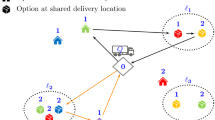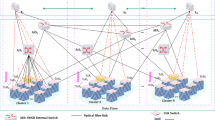Abstract
Advances in optical data transmission technology have allowed the current expansion of bandwidth-demanding services over the Internet. Also, the emergence of orthogonal frequency-division multiplexing (OFDM) has opened the possibility of increasing the network spectral efficiency by solving the routing, modulation and spectrum assignment (RMSA) problem. Recently, investigators have examined the effects of multiple demands or multiple virtual topologies when they are requested at different time periods over a single physical substrate. That makes the RMSA harder and with many more instances. Such analysis is required because network traffic does not remain static along time, and the demand can increase considerably as new user services arise. Therefore, planning the network considering a multi-period study becomes essential, since it can prevent a case where demands may exceed the bandwidth capacity and cause request blocking in future periods. In this work, we provide a novel mixed integer linear programming (MILP) formulation to solve the RMSA problem for several t periods of demands. This model can be used not only to find the solutions to minimize the used capacity, but also as an efficient method of network planning, since it can estimate with a single formulation and a single iteration the point of resource exhaustion in each period t. The results are found for a small network, and they show the efficiency of the proposed MILP formulation. We also propose an alternative version of this formulation with predefined paths, which is less computationally demanding. The results of this study are compared to a step-by-step planning, where the strategy is a decomposition method that breaks the previous formulation into t steps. Comparing the results of the two strategies, it can be seen that the single multi-period formulation is a good strategy to solve the problem. By contrast, the step-by-step strategy may require reconfigurations and eventual interruptions in the network, from a step to another one.








Similar content being viewed by others
Notes
In this paper, each traffic demand matrix is associated with a period.
References
Cisco V (2017) The zettabyte era: trends and analysis. Updated (07/06/2017). http://www.hit.bme.hu/~jakab/edu/HTI18/Litr/Cisco_The_Zettabyte_Era_2017June__vni-hyperconnectivity-wp.pdf
Ellis AD, Suibhne N Mac, Saad D, Payne DN (2016) Communication networks beyond the capacity crunch. Phil Trans R Soc A 37420150191. pp 1-14
Chralyvy A (2009) Plenary paper: The coming capacity crunch. In: 2009 35th European conference on optical communication. IEEE
Assis KD, Hammad A, Almeida RC, Simeonidou D (2016) Approaches to maximize the open capacity of elastic optical networks. In: IEEE international conference on communications–ICC, pp 1–6
Waldman H (2018) The impending optical network capacity crunch. In: IEEE SBFoton international optics and photonics conference–SBFoton IOPC 1–4
Jinno M et al (2009) Spectrum-efficient and scalable elastic optical path network: architecture, benefits, and enabling technologies. IEEE Commun Mag 47(11):66–73
Kozicki B, Takara H, Yoshimatsu T, Yonenaga K, Jinno M (2009) Filtering characteristics of highly-spectrum efficient spectrum-sliced elastic optical path (SLICE) network. In: (OSA) optical fiber communication conference, pp JWA43
Chatterjee Bijoy, Oki Eiji (2020) Elastic optical networks: fundamentals. control, and management. CRC Press, Boca Raton
Abkenar FS, Rahbar AG (2017) Study and analysis of routing and spectrum allocation (RSA) and routing, modulation and spectrum allocation (RMSA) algorithms in elastic optical networks (EONs). Opt Switch Netw 23:5–39
Wang Yang, Cao Xiaojun, Pan Yi (2011) A study of the routing and spectrum allocation in spectrum-sliced elastic optical path networks. In: IEEE Infocom, pp 1503–1511
Christodoulopoulos K, Tomkos I, Varvarigos EA (2011) Elastic bandwidth allocation in flexible OFDM-based optical networks. J Lightwave Technol 29(9):1354–1366
Abedifar V et al (2018) Routing, modulation, and spectrum assignment in programmable networks based on optical white boxes. J Opt Commun Netw 10(9):723–735
Straub S, Kirstadter A, Schupke DA (2006) Multi-period planning of WDM-networks: comparison of incremental and EoL approaches. In: 2nd IEEE/IFIP international conference in central asia on internet, pp 1-7
Lardeux B, Nace D, Geffard J (2007) Multiperiod network design with incremental routing. Netw Int J 50(1):109–117
Gryseels M et al (2001) Long-term planning of optical networks. In: Optical fiber communication conference. optical society of America
Papanikolaou P, Christodoulopoulos K, Varvarigos E (2018) Optimization techniques for incremental planning of multilayer elastic optical networks. IEEE/OSA J Opt Commun Netw 10(3):183–194
Kronberger C, Schondienst T, Schupke DA (2011) Impact and handling of demand uncertainty in multiperiod planned networks. In: IEEE international conference on communications–ICC, pp 1–6
Manousakis K, Kollios P, Georgios E (2017) Multi-period attack-aware optical network planning under demand uncertainty. In: Optical fiber and wireless communications, p 49
Wong RT (2020) Telecommunications network design: technology impacts and future directions. Networks. pp 1-20. https://doi.org/10.1002/net.21997
Waldman H, Almeida RC, Bortoletto RC (2020) Performance gains imparted by traffic-awareness in an elastic single. In: 22nd international conference on transparent optical networks–ICTON, pp 1–5
López V, Velasco L (2016) Elastic optical networks. Architectures, technologies, and control. Springer Int. Publishing, Switzerland
Eira A, Pedro J, Pires J (2015) Optimal multi-period provisioning of fixed and flex-rate modular line interfaces in DWDM networks. J Opt Commun Netw 7(4):223–234
Soumplis P et al (2018) Multi-period planning with actual physical and traffic conditions. IEEE/OSA J Opt Commun Netw 10(1):A144–A153
Iyer S, Singh SP (2019) Multiple-period planning of internet protocol-over-elastic optical networks. J Inf Telecommun 3(1):39–56
Mesquita LAJ, Assis KDR, Santos AF, Alencar MS, Almeida RC (2018) A routing and spectrum assignment heuristic for elastic optical networks under incremental traffic IOPC. In: SBFoton international optics and photonics conference, pp 1–5
Velasco L et al (2016) On-demand incremental capacity planning in optical transport networks. IEEE/OSA J Opt Commun Netw 8(1):11–22
Morales F et al (2017) Virtual network topology adaptability based on data analytics for traffic prediction. IEEE/OSA J Opt Commun Netw 9(1):A4–A35
Gong L, Zhu Z (2013) Virtual optical network embedding (VONE) over elastic optical networks. J Lightwave Technol 32(3):450–460
Shirmarz A, Ghaffari A (2020) Performance issues and solutions in SDN-based data center: a survey. J Supercomput, pp 1–49
Nunes B, Astuto A et al (2014) A survey of software-defined networking: past, present, and future of programmable networks. IEEE Commun Surv Tutorials 16(3):1617–1634
Tanaka T, Hirano A (2014) An in-operation IP-over-optical network planning method that supports unpredictable IP traffic transitions. In: 2014 the European conference on optical communication–ECOC, pp 1–3
Eppstein D (1998) Finding the k shortest paths. SIAM J Comput 28(2):652–673
Chlamtac I, Ganz A, Karmi G (1992) Lightpath communications: an approach to high bandwidth optical WAN’s. IEEE Trans Commun 40(7):1171–1182
CPLEX, ILOG (2019) High-performance software for mathematical programming and optimization. http://www.ilog.com. Accessed 17 Oct 2020
Nie L et al (2016) Traffic matrix prediction and estimation based on deep learning in large-scale IP backbone networks. J Netw Comput Appl 76:16–22
Azzouni A, Pujolle G (2018) NeuTM: a neural network-based framework for traffic matrix prediction in SDN. In: NOMS IEEE/IFIP network operations and management symposium, pp 1–5
Zhao J et al (2018) Towards traffic matrix prediction with LSTM recurrent neural networks. Electron Lett 54(9):566–568
Acknowledgements
The authors would like to thank to CAPES and CNPq for scholarships, grants and the educational support to UFBA and UFPE.
Author information
Authors and Affiliations
Corresponding author
Additional information
Publisher's Note
Springer Nature remains neutral with regard to jurisdictional claims in published maps and institutional affiliations.
Rights and permissions
About this article
Cite this article
Mesquita, L.A.J., Assis, K.D.R. & Almeida, R.C. Multi-period traffic on elastic optical networks planning: alleviating the capacity crunch. J Supercomput 77, 5468–5491 (2021). https://doi.org/10.1007/s11227-020-03493-7
Accepted:
Published:
Issue Date:
DOI: https://doi.org/10.1007/s11227-020-03493-7




